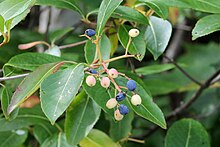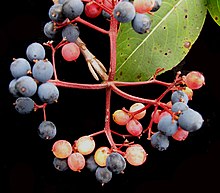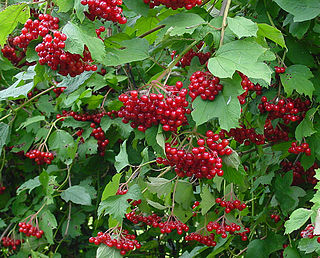
Viburnum is a genus of about 150–175 species of flowering plants in the moschatel family, Adoxaceae. Its current classification is based on molecular phylogeny. It was previously included in the honeysuckle family Caprifoliaceae.

Viburnum lentago, the nannyberry, sheepberry, or sweet viburnum, is a species of Viburnum native to North America.

The cardoon, also called the artichoke thistle, is a thistle in the family Asteraceae. It is a naturally occurring species that also has many cultivated forms, including the globe artichoke. It is native to the Mediterranean region, where it was domesticated in ancient times and still occurs as a wild plant.

Vaccinium erythrocarpum, commonly known as southern mountain cranberry or bearberry, more rarely as mountain blueberry or dingleberry, is a deciduous flowering shrub native to the Southeastern United States.

Viburnum opulus, the guelder-rose or guelder rose is a species of flowering plant in the family Adoxaceae native to Europe, northern Africa and central Asia.

Viburnum tinus, the laurustinus, laurustine or laurestine, is a species of flowering plant in the family Adoxaceae, native to the Mediterranean area of Europe and North Africa. Laurus signifies the leaves' similarities to bay laurel.

Viburnum trilobum is a species of Viburnum native to northern North America, from Newfoundland west to British Columbia, south to Washington state and east to northern Virginia. It is very closely related to the European and Asian Viburnum opulus, and is often treated as a variety of it, as Viburnum opulus L. var. americanum Ait., or as a subspecies, Viburnum opulus subsp. trilobum (Marshall) Clausen.

Calycanthus floridus, or commonly known as the eastern sweetshrub, Carolina all spice, or spicebush, is a species of flowering shrub in the family Calycanthaceae. It is identifiable by its dark red flowers and fragrant scent. It is non-invasive and is found in the Southeastern United States region. The Nature Conservancy considers its conservation status to be G5, globally secure, indicating it is at low risk of extinction. It is presumed to have been extirpated from Ohio.

Viburnum prunifolium is a species of Viburnum native to eastern North America, from Connecticut west to eastern Kansas, and south to Alabama and Texas.
Viburnum elatum is a species of woody plant in the family Adoxaceae. It is endemic to eastern Mexico.

Viburnum nudum is a deciduous shrub in the genus Viburnum within the muskroot family, Adoxaceae.

Ephedra altissima is a species of Ephedra that is native to the western Sahara, and also to the Canary Islands.

Viburnum edule, the squashberry, mooseberry, moosomin, moosewood viburnum, pembina, pimina, highbush cranberry, or lowbush cranberry is a species of shrub native to Canada and the northern parts of the US. It stands roughly 2 m (6.5 ft) tall with many stems and smooth branches.

Viburnum rufidulum, also known as the rusty blackhaw, blue haw, rusty nanny-berry, or southern black haw, is a flowering species of shrub or small tree that is common in parts of the Eastern and Central United States. It produces attractive flowers and fall foliage, as well as fruits that are popular with some species of bird.
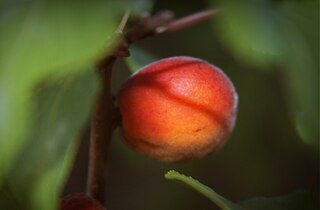
Prunus sibirica, commonly known as Siberian apricot, is a species of shrub or small tree native to northern China, Korea, Mongolia, and eastern Siberia. It is classified in the rose family, Rosaceae, and is one of several species whose fruit are called apricot, although this species is rarely cultivated for its fruit. The species was named by Carl Linnaeus in 1753.

Camellia taliensis is a small species of evergreen shrub whose leaves and leaf buds are used to produce tea.

Helwingia japonica, the Japanese helwingia, is a species of flowering plant the family Helwingiaceae. It is native to South-East Asia.
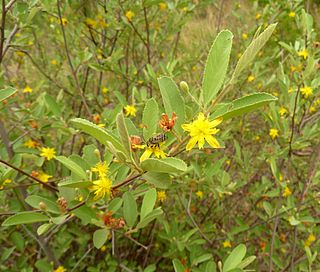
Grewia flava, the brandy bush, wild currant, velvet raisin, or raisin tree, is a species of flowering plant in the family Malvaceae, native to southern Africa. A common shrub species, it is spreading into grasslands due to human rangeland management practices, and increasing rainfall. The berries, which are yellowish-brown and slightly lobed, are sweet and edible, but have little flesh and so are typically collected in large quantities to be eaten raw, dried or fermented into alcoholic beverages. The wood has a number of uses such as for making bows, knobkerries, traps and other tools. The desert truffle Kalaharituber pfeilii is often found in association with its roots.

Viburnum cotinifolium, the Indian wayfaring tree, is a species of flowering plant in the family Viburnaceae. It is a deciduous shrub native to the Himalayan region. Its fruit is regularly consumed by Asiatic black bears.

Viburnum grandiflorum, variously called the cranberry bush, flowering viburnum, grand viburnum, and Himalayan viburnum, is a species of flowering plant in the family Viburnaceae, native to the Himalayan region. It grows in open forests. A sparse shrub or gnarled tree reaching 2–3 m (7–10 ft), it has showy pink flowers larger than the typical viburnum, and red to black fruit, which are edible. It is hardy to USDA zone 6a. The unimproved species is available from commercial suppliers, as is a putative form, Viburnum grandiflorum f. foetens, the stinking Himalayan viburnum, and a number of cultivars, including 'De Oirsprong', 'Desmond Clarke', and 'Snow White'.
